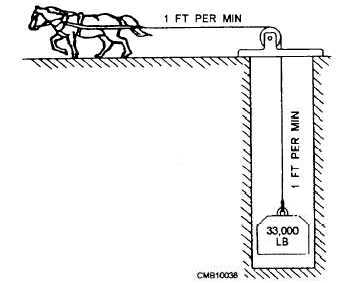pounds per minute (fig. 2-18). The formula for horsepower is the following:
Hp = ft-lb. per min / 33,000 = L x W / 33,000 x t
L = length, in feet, through which W is moved
W = force, in pounds, that is exerted through distance L
T = time, in minutes, required to move W through L
A number of devices are used to measure the hp of an engine. The most common device is the dynamometer.
An ENGINE DYNAMOMETER (fig. 2-19) may be used to bench test an engine that has been removed from a vehicle. If the engine does not develop the recommended horsepower and torque of the manufacturer, you know further adjustments and/or repairs on the engine are required.
The CHASSIS DYNAMOMETER (fig. 2-19) is used for automotive service, since it can provide a quick report on engine conditions by measuring output at various speeds and loads. This type of machine is useful in shop testing and adjusting an automatic transmission. On a chassis dynamometer, the driving wheels of a vehicle are placed on rollers. By loading the rollers in varying amounts and by running the engine at different speeds, you can simulate many driving conditions. These tests and checks are made without interference by other noises, such as those that occur when you check the vehicle while driving on the road.
Another device that measures the actual usable horsepower of an engine is the
PRONY BRAKE (fig. 2-20). It is used very little today, but is simple to understand. It is useful for learning the concept of horsepower-measuring tools. It consists of a flywheel surrounded by a large braking device. One end of an arm is attached to the braking device, while the other end exerts pressure on a scale. In operation, the engine is attached to, and drives, the flywheel. The braking device is tightened until the engine is slowed to a predetermined rpm. As the braking device slows the engine, the arm attached to it exerts pressure on a scale. Based on the reading at the scale and engine rpm, a brake horsepower valve is calculated by using the following formula:
6.28 x length of arm x engine rpm x scale reading / 33,000
It must be noted that 6.28 and 33,000 are constants in the formula, meaning they never change. For example, a given engine exerts a force of 300 pounds on a scale through a 2-foot-long arm when the brake device holds the speed of the engine at 3,000 rpm. By using the formula, calculate the brake horsepower as follows:
6.28 x 2 x 3000 x 300 / 33,000 horsepower = 342.55 brake
TORQUE is a force that, when applied, tends to result in twisting an object, rather than its physical movement. When the torque is being measured, the force that is applied must be multiplied by the distance from the axis of the object. Torque is measured in pound-feet (not to be confused with work which is measured in foot-pounds). When torque is applied to an object, the force and distance from the axis depends on each other. For example, when 100 foot-pounds of torque is applied to a nut, it is equivalent to a 100-pound

Figure 2-18. - Horsepower.
Continue Reading